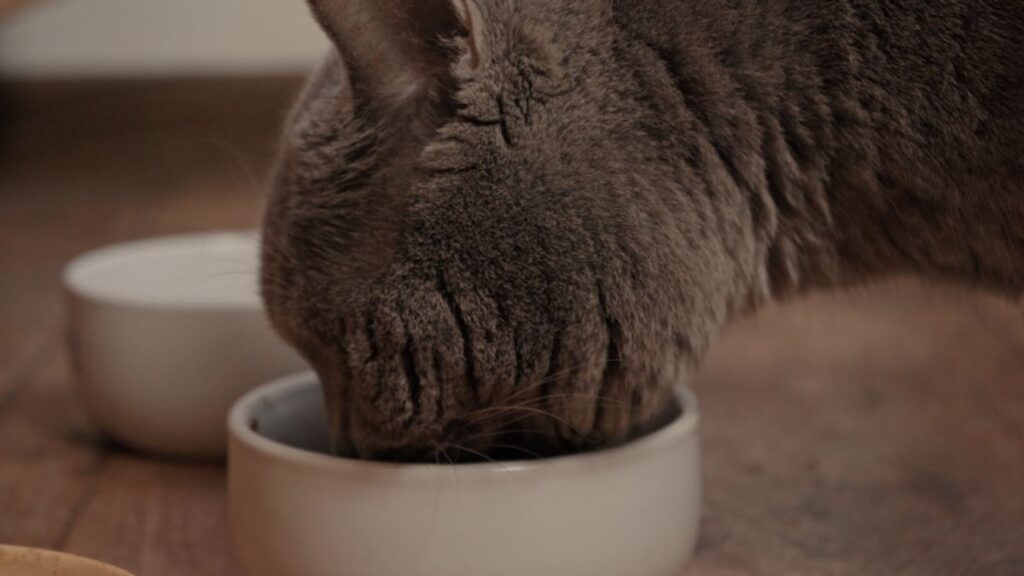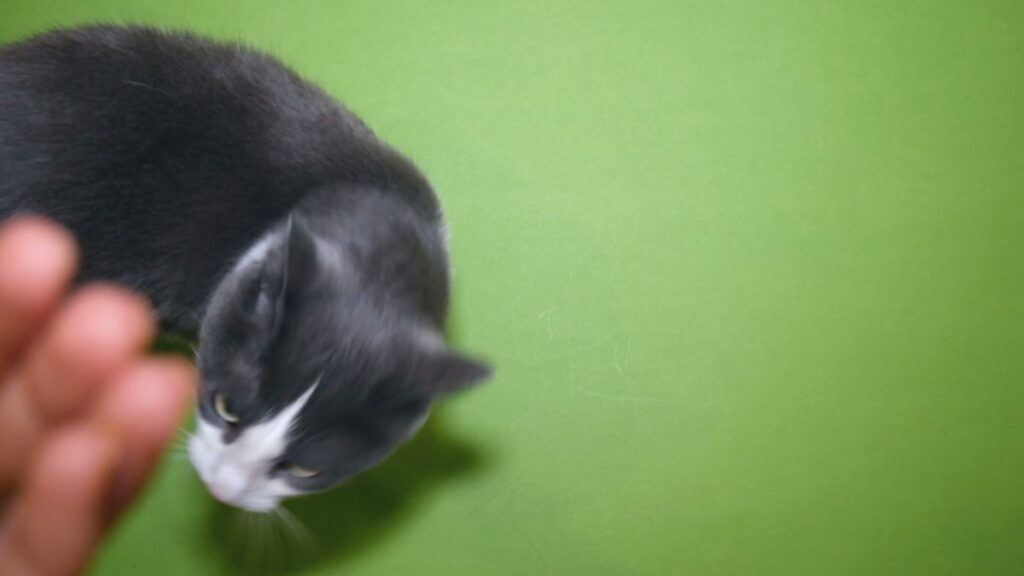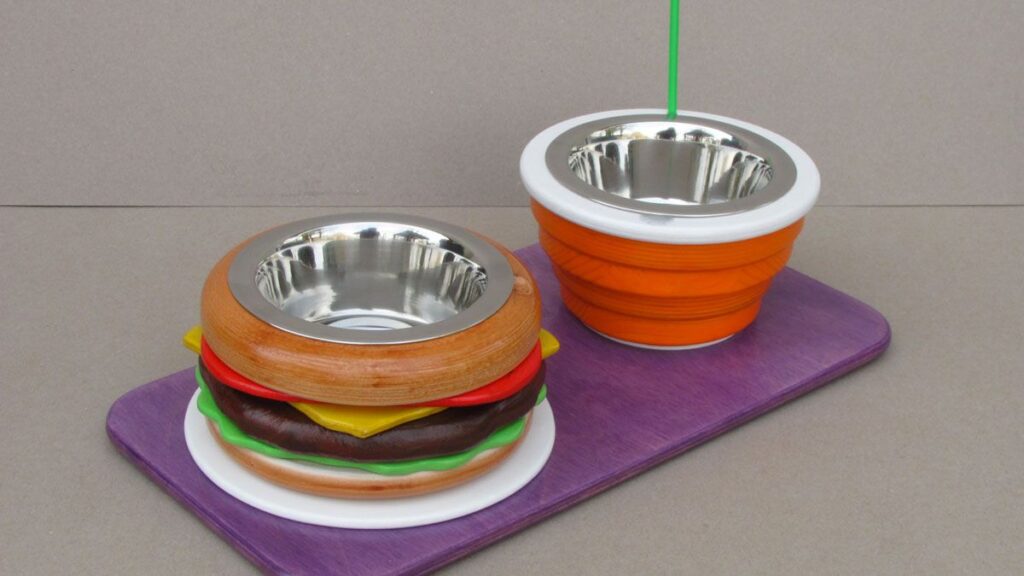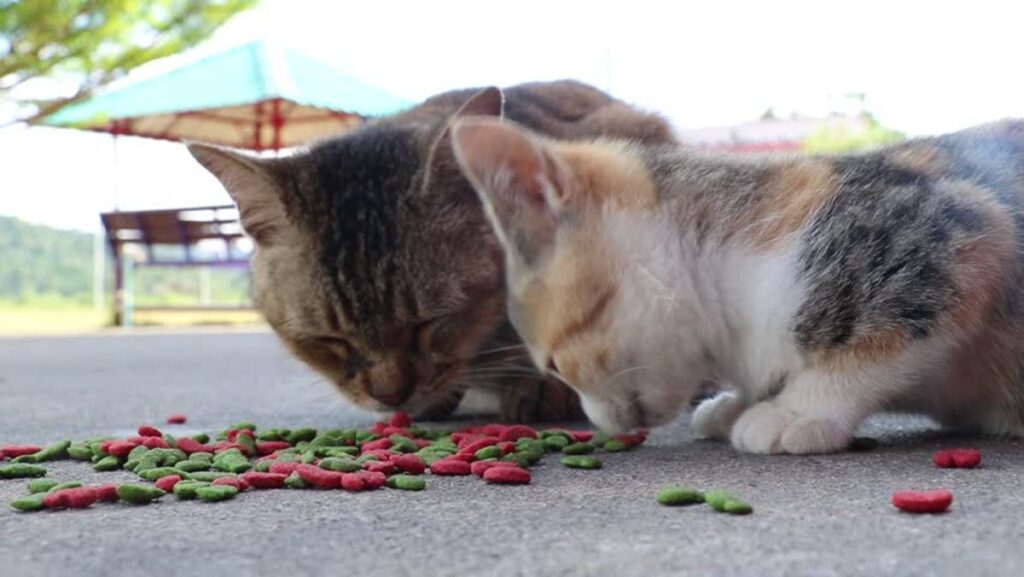Transitioning your cat to a new food can be a delicate process, but with the right approach, it can be done smoothly and without causing stress to your feline companion. Understanding the need for a dietary change, creating a well-thought-out transition schedule, and implementing it with care are essential steps. Encouraging your cat to accept the new food and completing the transition with patience and consistency will ensure your cat’s health and happiness. This article will guide you through each step of transitioning your cat to a new food, providing practical tips and advice to make the process as seamless as possible.
Key Takeaways
- Gradually mix new food with old, starting with a 75/25 ratio and adjusting over 7-10 days to prevent digestive issues.
- Monitor your cat’s response to the new food and adjust the transition pace as needed, consulting a vet if necessary.
- Use familiar scents and flavors to encourage acceptance of the new food, and maintain a positive feeding environment.
- Be patient and consistent, avoiding abrupt changes to your cat’s diet to ensure a smooth transition process.
- Once your cat is exclusively eating the new food without issues, the transition is complete; continue to monitor health.
Understanding the Need for Transition
Assessing Your Cat’s Current Diet
Before introducing a new diet, it’s crucial to evaluate your cat’s current eating habits and health. Start by observing your cat’s behavior around their food and note any signs of digestive discomfort or changes in appetite. A healthy diet should not cause gastrointestinal issues like vomiting or diarrhea.
Next, assess the nutritional content of your cat’s current food. Check the ingredients list for quality and suitability:
- Does the food meet your cat’s specific dietary needs?
- Are there any fillers or allergens that could be causing sensitivities?
Pay close attention to your cat’s coat and skin condition, as these can be indicators of their overall health and the effectiveness of their diet.
Lastly, consider your cat’s weight and energy levels. Sudden changes can signal that the current diet may not be optimal. Consulting with a veterinarian can provide valuable insights, especially if you notice any concerning health issues.
Selecting the Right New Food
When it’s time to introduce a new diet to your feline friend, selecting the right food is crucial for their health and happiness. Nutritional content should be your top priority; look for a balanced diet that caters to your cat’s age, activity level, and any specific health concerns. Essential nutrients such as proteins, vitamins, and minerals must be present to maintain optimal health.
Research is key in this process. Spend time looking into various cat food brands, and don’t hesitate to read reviews from other pet owners. Opt for brands with a strong reputation for quality and nutrition. It’s also beneficial to consider the ingredients list to ensure the food is free from fillers or additives that could be harmful or unappealing to your cat.
Gradually mixing the new food with familiar flavors can help ease the transition and increase the likelihood of acceptance.
Experimentation can also play a role in finding the perfect fit. Some cats may have a preference for wet over dry food, or they might be more inclined to try new flavors if they’re introduced alongside their current favorites. Paying attention to your cat’s preferences will guide you in making an informed decision that ensures their well-being.
Recognizing the Signs for Change
When considering a diet change for your cat, it’s crucial to observe their current health and behavior for signs that a transition may be necessary. Cats may exhibit certain symptoms that indicate their current diet is no longer suitable. For instance, a loss of appetite or digestive issues such as vomiting or diarrhea can be clear indicators. Additionally, external changes like a dull coat or skin problems, as well as significant weight gain or loss, should not be overlooked.
It’s also important to note behavioral changes related to food preferences. If your cat seems less interested in their meals or is behaving differently around feeding times, it may be time to consider a new dietary option. Any drastic changes in behavior or temperament warrant a discussion with your veterinarian to rule out underlying health issues.
Transitioning from kitten to adult or senior cat food is a common reason for changing a cat’s diet. For example, most kittens will need to switch to adult cat food around the 10-12 month mark, with larger breeds like the Maine Coon being an exception.
Creating a Transition Schedule

The Importance of a Gradual Transition
When introducing a new diet to your cat, a gradual transition is crucial to avoid digestive upset and to allow your cat to become accustomed to the new flavors and textures. An abrupt change in diet can lead to a refusal to eat, digestive problems, or even nutrient imbalances, which can be detrimental to your cat’s health.
By starting with a mix of 75% of the current food and 25% of the new food, you can create a comfortable introduction to the new diet. Over the course of 7-10 days, gradually adjust the proportions until the new food completely replaces the old.
This methodical approach not only eases your cat’s digestive system into accepting the new food but also provides an opportunity for you to monitor your cat’s acceptance and health. If any issues arise, you can adjust the transition plan accordingly to ensure a smooth and successful change in diet.
Developing a Transition Plan
When planning to transition your cat to a new diet, it’s essential to start with a mix of 75% old food to 25% new food. This initial ratio is crucial to avoid digestive upset and to allow your cat to become accustomed to the new flavors and textures.
Gradually adjust the proportions of old and new food over a period of 7-10 days, aiming for a smooth dietary shift.
Follow a structured approach to ensure a successful transition:
- Day 1-3: Serve 75% old food with 25% new food
- Day 4-5: Adjust to a 50/50 mix of both foods
- Day 6-7: Serve 25% old food with 75% new food
- Day 8-10: Transition completely to the new food
By adhering to this plan, you can monitor your cat’s response and make any necessary adjustments to the schedule.
Adjusting the Transition Based on Your Cat’s Response
When introducing a new diet, it’s essential to observe your cat’s reaction to the food transition and adjust accordingly. If your cat is hesitant or outright refuses the new food, slow down the transition process. Conversely, if your cat takes well to the new food, you may be able to speed up the schedule slightly. Always prioritize your cat’s comfort and health over a rigid timeline.
- Day 1-3: Maintain a higher proportion of old food.
- Day 4-6: Aim for a balanced mix of old and new food.
- Day 7+: Gradually increase new food proportions.
It’s important to be flexible and patient during this period. A successful transition is one that considers the well-being of your cat at every step.
Monitor for any signs of digestive upset, such as vomiting or diarrhea, and be prepared to revert to the previous ratio if necessary. Keep a close eye on your cat’s overall health, appetite, and behavior throughout the transition to ensure they are adjusting well to the change.
Implementing the Transition

Mixing New Food with Old
When introducing your cat to a new diet, it’s crucial to mix the new food with the old to prevent digestive upset. Begin with a ratio of 75% old food to 25% new food, and gradually adjust the proportions over the course of 7-10 days. This method helps your cat to adjust to the taste and texture of the new food without causing stress or health issues.
Gradually increase the proportion of the new food while decreasing the old food. Aim to reach a 50/50 mix by day 4 or 5, then continue to increase the new food’s share.
Monitor your cat’s health and eating habits closely during this period. If you notice any signs of digestive upset or reluctance to eat, it may be necessary to slow down the transition. Here’s a simple schedule to follow:
- Day 1-3: 75% old food, 25% new food
- Day 4-5: 50% old food, 50% new food
- Day 6-7: 25% old food, 75% new food
- Day 8-10: 100% new food
Adjusting the pace of the transition based on your cat’s response is key to a successful dietary change. If your cat experiences any issues, maintain a higher proportion of the old food until they are more comfortable with the change.
Monitoring Your Cat’s Health Throughout the Process
As you introduce new food to your cat’s diet, it’s crucial to closely observe their health and behavior for any changes. Regular weigh-ins are an essential part of this monitoring to track your cat’s weight stability. Significant weight fluctuations could signal nutritional imbalances or health issues that may require veterinary attention.
During this period, be vigilant for signs of digestive discomfort, such as changes in appetite, vomiting, or irregular bowel movements. These symptoms can indicate that your cat is not adjusting well to the new diet and may need a slower transition or a different food formulation.
Behavioral changes are also noteworthy. A shift in your cat’s temperament or activity levels can be a response to the new diet. If you notice persistent or concerning changes, it’s advisable to consult with your veterinarian to rule out any health complications.
Troubleshooting Common Issues
When transitioning your cat to a new food, you may encounter some hurdles. Cats can be particularly finicky eaters, and their reluctance to try new foods can lead to a few common issues. Here’s how to address them:
- Refusal to Eat: Mix in more of the old food and gradually decrease it over time.
- Digestive Upset: Slow down the transition process and consult your vet if symptoms persist.
- Selective Eating: Remove the old food entirely for a short period, then reintroduce the mix.
It’s crucial to monitor your cat’s behavior and health closely during the transition. Any persistent issues should be discussed with a veterinarian to rule out underlying health problems.
Remember, each cat is unique, and what works for one may not work for another. Be patient and willing to adjust your approach as needed to ensure a successful transition to the new diet.
Encouraging Acceptance of New Food

Strategies to Help Your Cat Accept the New Food
Introducing a new diet to your cat can be challenging, but with the right strategies, you can ease the transition and promote acceptance. Start by mixing the new food with the old, allowing your cat to become accustomed to the new flavors and textures in a familiar context. Gradually increase the proportion of new food over time.
Offering a variety of flavors and textures can also be beneficial. Cats have individual preferences, and finding the right combination that appeals to your pet can make a significant difference. Here’s a simple plan to follow:
- Day 1-3: Mix 25% new food with 75% old food
- Day 4-6: Increase to a 50/50 mix
- Day 7-9: Mix 75% new food with 25% old food
- Day 10: Serve 100% new food
Trial and observation are key during this period. Monitor your cat’s response to the new diet and be prepared to adjust the plan if necessary.
Incorporating food puzzles or toys can turn mealtime into a stimulating activity, encouraging your cat to engage with the new food. This can be particularly effective for cats that are motivated by play or those that need a slower feeding pace to prevent digestive upset.
Using Familiar Scents and Flavors
Cats rely heavily on their sense of smell, so introducing new food can be less stressful when it’s combined with familiar scents. Gradually mix the new food with the old, allowing your cat to adjust to the change in taste and texture while still enjoying the comfort of the known. This can be particularly effective if the old food had a distinct smell that your cat was fond of.
Experiment with different flavors and textures to find a combination that your cat prefers. Some cats may have a preference for wet over dry food, or vice versa. Here’s a simple plan to incorporate familiar scents:
- Day 1-3: Mix 25% new food with 75% old food
- Day 4-5: Reach a 50/50 mix
- Day 6-7: Mix 75% new food with 25% old food
- Day 8: Completely transition to new food
Trial and observation are key during this process. Introduce small portions of the new food and observe your cat’s response. Look for signs of acceptance, such as eagerness to eat and positive changes in appetite and overall health.
If your cat shows signs of reluctance or digestive upset, slow down the transition process. Maintain a higher proportion of the old food until they adjust, ensuring a smoother transition for your feline friend.
Creating a Positive Feeding Environment
To foster a positive feeding environment, consider the ambiance and routine around mealtime. Cats thrive on consistency, so maintaining a regular feeding schedule in a quiet, stress-free area can make a significant difference.
Use food puzzles or toys to make mealtime more engaging. This not only stimulates their natural hunting instincts but also makes the new food more enticing. Here’s how you can integrate play into feeding:
- Introduce food puzzles that require your cat to work for their meal.
- Rotate different toys to keep the experience fresh and interesting.
- Encourage exploration and play by hiding small amounts of food around the house.
Gradually introduce the new food by mixing it with small amounts of their current favorite food. This will help familiarize your cat with the new scent and taste, easing the transition.
By implementing these strategies and being patient and persistent, you can help encourage your cat to accept the new food and ensure they receive a balanced and nutritious diet. Transitioning cats to high-protein diets requires monitoring and hydration. Sustainable pet food options include ethically sourced proteins, insect-based proteins, and plant-based alternatives for a more eco-friendly future.
Completing the Transition

Gradually Increasing New Food Proportions
As you approach the midpoint of the transition period, aim for a 50/50 mix of old and new food. This balance is crucial as it allows your cat to adjust to the change while still receiving the familiar nutrients and flavors they’re accustomed to.
Gradually increasing the new food proportions is essential to a successful dietary transition. It minimizes the risk of digestive upset and helps your cat to adapt to the new taste and texture.
Continue to observe your cat’s reaction to the new diet. If you notice any signs of digestive discomfort or reluctance to eat, it’s important to slow down the transition. Maintain a higher ratio of the old food until your cat seems comfortable with the change. Here’s a simple schedule to follow:
- Day 1-3: 75% old food, 25% new food
- Day 4-5: 50% old food, 50% new food
- Day 6-7: 25% old food, 75% new food
- Day 8+: 100% new food
Adjust this schedule based on your cat’s response, and always consult your veterinarian if you’re unsure about the appropriate proportions or if your cat shows persistent signs of discomfort.
Maintaining Consistency
Once your cat has fully transitioned to the new diet, it’s crucial to maintain the same feeding routine. Consistency in feeding times, portions, and the location of the food bowl can help your cat feel secure and prevent digestive issues.
It’s essential to supervise your cat with new foods and ensure they stay hydrated throughout the process. A balanced diet, including high-quality food and treats, is vital for your cat’s health.
If you notice any changes in your cat’s behavior or health, it’s important to consult your vet. They can provide personalized advice on your cat’s nutrition and help you make any necessary adjustments to their diet.
Final Steps to Ensure a Successful Transition
Once your cat has adapted to the new diet, it’s crucial to continue monitoring their health and dietary response. This includes observing their energy levels, coat condition, and overall well-being. If any issues arise, it may be necessary to reassess the food choice or the transition process.
It’s essential to maintain a consistent feeding routine during this final phase to avoid causing confusion or stress for your cat. Consistency in meal times and portion sizes will help solidify the new diet as part of their regular regimen.
As the transition concludes, keep a close eye on your cat’s weight and behavior. Any significant changes should be discussed with your vet, especially if you suspect any adverse reactions to the new food. Consulting with your vet for personalized recommendations is always a wise step to ensure the dietary needs of your cat are fully met.
Conclusion
Transitioning your cat to a new food can be a delicate process, but with patience and a strategic approach, it can be done smoothly, ensuring your cat’s health and happiness. Remember to be patient and consistent, providing plenty of fresh water and gradually increasing the new food while decreasing the old. By following the tips and steps outlined in this article, you can help your cat adjust to their new diet with minimal stress. Always monitor your cat’s health throughout the transition and consult your veterinarian if any concerns arise. Ultimately, a successful transition to a new food will contribute to your cat’s well-being for years to come.
Frequently Asked Questions
How do I transition my cat to a new diet?
Transition your cat’s diet gradually over 7-10 days by mixing the new food with the current food, starting with a 75% old to 25% new ratio and increasing the new food portion daily. Monitor for digestive upset and consult a vet if needed.
How can I encourage my cat to eat the new food?
Mix small amounts of the new food with familiar food gradually, and increase the new food portion daily. Use familiar scents and flavors, and make the transition slowly while monitoring their acceptance.
What happens if I don’t gradually transition my cat’s food?
Abrupt changes can lead to refusal to eat, digestive issues, or nutrient imbalances. A gradual transition helps prevent digestive upset and allows your cat to adjust to the new taste and texture.
Can I mix treats with my cat’s new food to make it more appealing?
Yes, mixing in some of your cat’s favorite treats or wet food with the new kibble can entice them to eat. However, do this sparingly to ensure they get used to the new food itself.
How do I know if my cat is having trouble with the transition?
Monitor your cat’s response to the new diet. Signs of trouble include digestive upset, refusal to eat, or behavioral changes. If you notice any issues, slow down the transition and consult your veterinarian.
What final steps should I take to ensure a successful transition?
Once your cat is eating the new food without issues, gradually increase the proportion of the new food while decreasing the old food until the new diet is exclusive. Maintain consistency and provide plenty of fresh water.

Saira is the lead writer behind Cat Care Guide, a blog focused on providing cat owners with authoritative advice on feline health, nutrition, behavior, and more. As a zoologist specializing in microbiology and a dedicated cat owner for over 10 years, Saira combines her formal education, extensive research, and firsthand experience caring for cats into deeply researched blog content you can trust.
When she’s not working on new articles for Cat Care Guide, you can find Saira continuing to self-educate on the latest cat health developments, doting on her own cats at home, or volunteering at the local animal shelter. With a true passion for cat care and welfare, Saira’s mission is to help fellow cat lovers nurture happy, healthy lives for their feline companions.
Please feel free to reach out to Saira with any questions about caring for your cat! If needed, contact via the website contact form.
